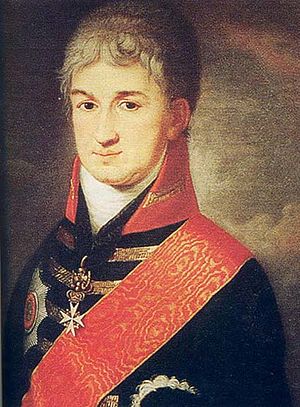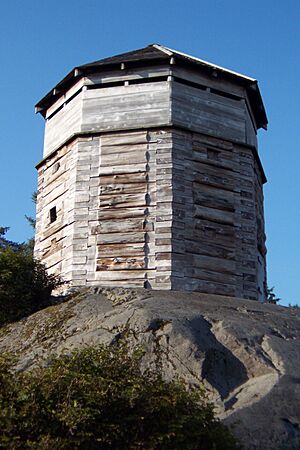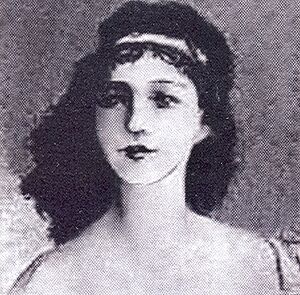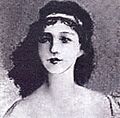Nikolai Rezanov facts for kids
Nikolai Petrovich Rezanov (Russian: Николай Петрович Резанов) (28 March [O.S. 8 April] 1764 – 13 March [O.S. 1 March] 1807) was a Russian nobleman and important statesman. He worked to promote Russian settlements in Alaska and California. He presented his ideas to three different Russian Emperors: Catherine the Great, Paul, and Alexander I.
Emperor Alexander I sent Rezanov as a Russian ambassador to Japan in 1804. His goal was to create a trade agreement. To get to Japan, he was made a co-commander of the First Russian circumnavigation (1803-1806), which was led by Adam Johann von Krusenstern. Rezanov left this journey in 1805 after visiting Japan.
Rezanov wrote a dictionary for the Japanese language and other works. These are kept in the library of the Saint Petersburg Academy of Sciences. He was a member of this Academy. Rezanov's most important achievement was helping to start the Russian-American Company in 1799.
Contents
Nikolai Rezanov's Early Life
Nikolai Rezanov was born in Saint Petersburg, Russia, on March 28, 1764. He was very smart and could speak five different languages by the time he was 14 years old!
At 14, he joined the Izmaylovsky Regiment, a military group. He left five years later in 1784 as a captain. After that, Rezanov worked for five years as a court officer in Pskov. In 1791, he started working for Gavrila Derzhavin, who was the private secretary to Empress Catherine.
A powerful person named Platon Zubov became interested in Rezanov. Within a year, Zubov hired him as an assistant. Zubov was also interested in the fur trade activities of a merchant named Grigory Shelikhov. Zubov used his influence with Empress Catherine II to help Shelikhov get priests and settlers for his communities on the Kodiak Islands.
Rezanov and the Fur Trade
In the winter of 1793, Rezanov was chosen to be Zubov's personal representative. His job was to check on the new fur trade operations. In August 1794, Rezanov arrived in Irkutsk. This city was the main center for the Shelikhov-Golikov Company. His father had worked there for many years.
Rezanov likely visited Kyakhta with Shelikhov during the yearly trading with the Qing Empire (China). Rezanov thought the land routes to China were "inefficient" compared to how the British traded by sea in Guangzhou.
In January 1795, Rezanov married Anna, who was the 14-year-old daughter of Grigory and Natalia Shelikova. Anna brought shares in her father's company as part of her dowry. Sadly, Anna died seven years later while giving birth. Rezanov became a partner in the company. He quickly became a very active and hardworking businessman.
After Shelikhov died in 1795, Rezanov became a leading figure in the company. However, he felt pushed aside because Shelikhov's strong wife, Natalia, was the main heir. Rezanov decided to try and get a special royal charter for the company. This charter would give him and his partners a monopoly (exclusive right) to control and profit from the fur trade, similar to what the East India Company had in Great Britain.
Starting the Russian-American Company
Rezanov had just convinced Catherine II to sign his charter when she died in 1796. This meant he had to start all over again to get a charter from the new Emperor, Paul I. For a while, it seemed impossible. But Rezanov was very skilled and managed to get the Emperor to sign the Ukase of 1799. This happened just before Emperor Paul was assassinated.
The Russian-American Company (RAC) was given a special right to control the fur trade along the Pacific Northwest coast of North America. This area stretched from about the southern border of Alaska today, northward. It also included the chain of islands from Kamchatka north to Alaska and south to Japan. This monopoly lasted for twenty years.
Because Rezanov was a government official, he couldn't be a direct director of the company. So, he was officially called the RAC's "High Representative in the Capital." The Shelikhov family owned most of the company shares. However, Rezanov, Emperor Paul, the future Emperor Alexander I of Russia, and Grand Duke Constantine Pavlovich also owned shares.
At first, the company made good profits. But in the early 1800s, poor management and a lack of food caused serious problems. To help the company, the First Russian circumnavigation journey was planned. Rezanov was on board. The ships would bring supplies to the colonies in America. They would also start a Russian fur trade between Alaska, Japan, and China, and collect scientific information.
Rezanov was also given a special job: to open diplomatic relations with the Tokugawa Shogunate in Japan, which was a very isolated country. Before reaching Japan, the Russians visited Hawaii. There, they learned that a Russian colony called Redoubt Saint Michael in America had been destroyed. The Neva, one of the two ships, was sent north on May 31, 1804. It was very important in helping to take back Saint Michael in the Battle of Sitka later that year.
Rezanov was very impressed with how much food could be grown in Hawaii. He said that "All of Siberia might be supplied by sugar from Owhyhee". Rezanov and the rest of the crew, led by Adam Johann von Krusenstern, then sailed on the Nadezhda to Petropavlovsk.
The Nadezhda finally left for Japan in the autumn of 1804. It entered Nagasaki Bay in September. Rezanov did not make a good impression on his Japanese hosts. A Japanese translator told him, "All of Japan is talking of you and saying that you are different from the Dutch, prouder, more heated and that you look down on the Japanese." After many months of waiting for the Shogun's decision about trade, the Russians left Nagasaki on April 5, 1805. Their efforts to open trade were unsuccessful.
The Nadezhda returned to Petropavlovsk on May 24, 1805. There, Rezanov found orders telling him to stay in the Russian colonies. He was to be an Imperial inspector and company representative. His job was to fix the problems that were ruining the company. He left on the ship Maria on July 28 for Novo-Arkhangelsk (New Archangel) by way of the Aleutian islands.
While visiting the colonies, Rezanov put rules in place to protect fur-bearing animals from being hunted too much, especially on the Pribilof Islands. He also punished or removed people who broke the company's rules. He started several schools and libraries, even donating some of his own books. He also started cooking schools that were popular for a short time.
Journey to California
Life in the Russian colonies was very hard. Homes were simple, and food was scarce. Many supply ships were lost at sea. In 1806, the settlers at Sitka were suffering from scurvy (a disease caused by lack of Vitamin C) and starvation.
In desperation, on February 26, 1806, Rezanov gathered a small crew. He sailed south on the ship Juno on a very important trip to California. His goal was to buy food and supplies from the Spanish, who were Russia's main rivals in settling the Pacific coast.
Sick with hunger and scurvy, they arrived at San Francisco Bay on March 27. They met with Don José Darío Argüello, the commander of San Francisco. During their six-week stay, Rezanov successfully traded and bought wheat, barley, peas, beans, flour, and other important items. They left on May 10 and reached Sitka on June 8.
During his visit, Rezanov became close with 15-year-old Concepción Argüello ("Conchita"), who was the daughter of the Spanish commander. They became engaged, which caused a lot of talk in California society. This was especially true because they were from different religions and countries. But Rezanov's diplomatic skills convinced the local church leaders.
Rezanov got the governor's promise to send a copy of a trade agreement to Spain right away. Rezanov then went to Petropavlovsk. From there, he sent his ships to attack the Japanese island of Sakhalin. He did this without the Emperor's permission. Rezanov then began an overland trip to Saint Petersburg. He hoped to get the Emperor's approval for the trade agreement and his marriage. He even wrote personal letters to the Pope and the King of Spain asking for permission for his marriage.
Rezanov's Death
Nikolai Rezanov died from a fever and exhaustion in Krasny Yar (now Krasnoyarsk), Siberia, on March 8, 1807. His original grave was destroyed. However, his remains were later reburied.
On October 28, 2000, a special service was held at Rezanov's grave in Krasnoyarsk. A memorial was dedicated to him. Poets have written about the story of Rezanov and Conchita, making it a famous romance in Russia. The memorial has a white cross. On one side, it says: "Nikolai Petrovich Rezanov 1764 — 1807. I will never forget you." On the other side, it says: "Maria Concepcion de Arguelio 1791 — 1857. I will see you never more."
Rezanov's Impact
Rezanov had big plans for Russia. He wanted Russia to take control of the entire western coast of North America. He also wanted to encourage many people from Russia to move there. If he had lived, it is likely he would have achieved his goals.
However, the trade agreement with California was never signed. Rezanov's plans for improving the colonies failed after his death. The colonies slowly declined. And the Spanish girl, Conchita, who loved Rezanov, later became a nun.
Rezanov's Legacy
Rezanov's romance with Concepción became the subject of a famous ballad called Concepcion de Arguello by the author Francis Bret Harte. It was also featured in a 1937 novel, Rezánov and Doña Concha, by Gertrude Atherton.
In 1979, the composer Alexei Rybnikov and the poet Andrey Voznesensky wrote one of the first Russian rock operas. They chose the love story of Rezanov and Concepcion as their topic. They named the opera after two of Rezanov's ships, Juno and Avos. The original show has been very successful at the Lenkom Theatre and is still performed today.
In 2000, Gary E. Brown, the Police Chief of Monterey, California, attended a special service for Rezanov and Conchita in Siberia. He scattered earth from Conchita's grave and a rose from her burial site on Rezanov's tomb. He also took some earth from Rezanov's grave to scatter on Conchita's resting place in Benicia, CA. Chief Brown said, "It will connect them forever in a symbolic way." He added that their love story, which happened 200 years ago, forever linked the cities of Krasnoyarsk and Monterey.
Images for kids
See also
 In Spanish: Nikolái Rezánov para niños
In Spanish: Nikolái Rezánov para niños









